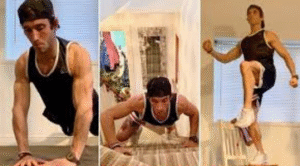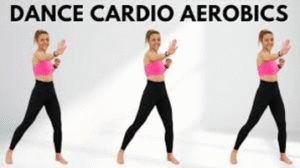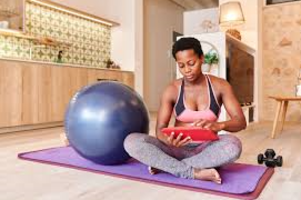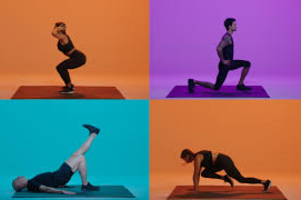Expensive gym memberships and specialized equipment are not necessary for getting in shape. The truth is that your living room can become the perfect fitness sanctuary with the right approach to simple daily exercises to stay fit at home.
Have you ever wondered why so many fitness enthusiasts are ditching their gym memberships for home-based routines? The answer lies in convenience, cost-effectiveness, and the ability to maintain consistency without the barriers of commuting or scheduling around facility hours.
The beauty of exercising at home lies in its adaptability. You can start your day with energizing movements, squeeze in a quick session during lunch breaks, or wind down with gentle stretches before bed. This flexibility makes it easier to build lasting habits that stick, which is ultimately the key to long-term fitness success.

The Foundation of Effective Home Fitness
Simple daily exercises to stay fit at home should target all major muscle groups while improving cardiovascular health, flexibility, and strength. The most successful home fitness routines combine compound movements that work multiple muscles simultaneously with targeted exercises that address specific areas.
Consistency over intensity
This remains the golden rule of home fitness. A 20-minute daily routine performed consistently delivers far better results than sporadic hour-long sessions. This approach prevents burnout while allowing your body to adapt gradually, reducing injury risk and building sustainable habits.
Creating a designated workout space, even if it’s just a corner of your bedroom, helps establish a mental connection between that area and physical activity. This psychological trigger makes it easier to transition into workout mode and maintain focus during your exercise sessions.
Essential Bodyweight Exercises for Daily Fitness
Push-ups
This serves as the foundation for at-home upper body strength training. This versatile exercise targets your chest, shoulders, triceps, and core while requiring zero equipment. Start with modified push-ups on your knees if standard push-ups feel challenging, gradually progressing to full push-ups as your strength improves. Advanced practitioners can explore variations like diamond push-ups, wide-grip push-ups, or elevated feet push-ups to continuously challenge their muscles.

Squats
Squats deserve recognition as the ultimate lower body exercise for home fitness enthusiasts. This fundamental movement pattern strengthens your quadriceps, hamstrings, glutes, and calves while improving hip mobility and functional strength. Focus on proper form by keeping your chest up, knees tracking over your toes, and descending until your thighs are parallel to the floor. Progress by adding jump squats or single-leg pistol squats as your strength develops.
Planks
Planks provide unmatched core strengthening benefits while improving overall stability and posture. Begin with 30-second holds, focusing on maintaining a straight line from your head to your heels. Avoid letting your hips sag or pike up, as proper alignment maximizes the exercise’s effectiveness. Advance to side planks, plank variations with arm or leg movements, or extended hold times as your core strength improves.
Lunges
This offers excellent unilateral training, addressing muscle imbalances while strengthening your entire lower body. Forward lunges, reverse lunges, and lateral lunges each target slightly different muscle groups and movement patterns. This variety ensures comprehensive lower body development while improving balance and coordination.
Burpees
Combine strength training with cardiovascular conditioning, making them incredibly efficient for time-conscious fitness enthusiasts. This full-body exercise elevates your heart rate while working virtually every muscle group. Start with a simplified version by stepping back into the plank position instead of jumping, gradually progressing to the full explosive movement.
Cardiovascular Training Without Equipment
High-Intensity Interval Training (HIIT)
Transforms your living room into a cardio powerhouse. Alternating between periods of intense activity and brief recovery creates an incredible cardiovascular workout while boosting metabolism for hours after your session ends. A simple HIIT routine might include 30 seconds of jumping jacks followed by 30 seconds of rest, repeated for 10-15 rounds.
Mountain climbers
This provide intense cardiovascular training while strengthening your core and improving coordination. Start in a plank position and alternate bringing your knees toward your chest in a running motion. Maintain proper plank alignment throughout the movement to maximize effectiveness and prevent injury.

Dancing
Dancing provides an enjoyable substitute for conventional aerobic exercises. Put on your favorite upbeat music and move for 15-20 minutes. This enjoyable approach to cardiovascular fitness doesn’t feel like exercise, making it easier to maintain consistency while burning calories and improving coordination.
Stair climbing
This utilizes existing home infrastructure for excellent cardiovascular training. If you have stairs in your home or apartment building, walking or running up and down provides intense lower body strengthening combined with cardiovascular benefits. As your fitness increases, progressively increase the number of journeys from five to ten.
Flexibility and Mobility Work
Dynamic stretching
Dynamic stretching before workouts prepare your muscles and joints for movement while reducing injury risk. Arm circles, leg swings, and hip circles activate the muscles you’ll use during your workout while improving range of motion. Spend 5-10 minutes on dynamic stretching before beginning your strength or cardio exercises.
Static stretching
Enhances flexibility and aids in recuperation after exercise. Concentrating on the main muscle groups you engage during your workout, hold each stretch for 30 to 60 seconds. Common post-workout stretches include hamstring stretches, hip flexor stretches, chest stretches, and shoulder stretches.

Yoga flows
Combines flexibility work with strength training and mindfulness. Simple sequences like sun salutations provide full-body movement while improving flexibility, balance, and mental well-being. Yoga can have a big impact on your stress levels and general health in as little as ten to fifteen minutes.
Foam rolling
Using a foam roller or even a tennis ball helps release muscle tension and improve recovery. Target common tight areas like your calves, IT bands, quadriceps, and upper back. This self-massage technique improves blood flow and reduces muscle soreness.
Creating Your Daily Exercise Routine
Morning routines
Energize your body and mind for the day ahead. A 15-20 minute morning session might include dynamic stretching, bodyweight exercises, and brief cardio intervals. This approach jumpstarts your metabolism while creating a positive mindset for the day.
Lunch break workouts
This provide an excellent way to break up long work days while boosting afternoon energy levels. Quick 10-15 minute sessions can include desk stretches, bodyweight exercises, or brief walks around your neighborhood. These midday movement breaks improve productivity and reduce stress.
Evening routines
Can help you unwind while maintaining fitness consistency. Focus on gentler exercises like yoga, stretching, or light bodyweight movements. Avoid intense cardio close to bedtime, as it may interfere with sleep quality.
Weekend sessions
Offers opportunities for longer, more comprehensive workouts. Use Saturday or Sunday for 30-45 minute sessions that combine strength training, cardio, and flexibility work. This extended time allows for more variety and progression in your routine.
Nutrition and Hydration for Home Fitness
Pre-workout nutrition
This provides energy for effective exercise sessions. Light snacks combining carbohydrates and protein, consumed 30-60 minutes before exercise, optimize performance and prevent fatigue. Examples include banana with peanut butter, Greek yogurt with berries, or a small handful of nuts and dried fruit.
Post-workout nutrition
Supports recovery and muscle adaptation. Consuming protein within 30-60 minutes after exercise helps repair and build muscle tissue, while carbohydrates replenish energy stores. Chocolate milk, protein smoothies, or turkey and cheese wraps make excellent post-workout options.
Hydration
Remains crucial for optimal performance and recovery. Drink water throughout the day, increasing intake on workout days or in hot weather. Proper hydration supports every bodily function while preventing fatigue and maintaining exercise performance.
Meal timing
Meals timed around workouts can impact energy levels and recovery. Avoid heavy meals within 2-3 hours of intense exercise, as digestion diverts blood flow from working muscles. Similarly, don’t exercise on an empty stomach if you feel weak or lightheaded.
Tracking Progress and Staying Motivated
Progress photos provide visual evidence of your fitness journey, often revealing changes that scales or measurements miss. Take photos from multiple angles in consistent lighting and clothing weekly or biweekly. These images become powerful motivation tools during challenging periods.
Workout logs help track consistency and progression over time. Record exercises performed, repetitions completed, and how you felt during each session. This data reveals patterns and progress that might otherwise go unnoticed.
Fitness apps offer structure and accountability for home workouts. Many free applications provide guided routines, progress tracking, and community support. Choose apps that align with your fitness goals and preferred exercise styles.
Accountability partners increase adherence to exercise routines. Share your goals with family members, friends, or online communities. Regular check-ins and shared experiences make the fitness journey more enjoyable and sustainable.
Overcoming Common Home Workout Challenges
Space limitations
Require creative exercise selection and equipment choices. Focus on exercises that can be performed in a 6×6 foot area, utilizing vertical space when possible. Resistance bands, suspension trainers, and adjustable dumbbells maximize exercise options while minimizing storage requirements.
Time constraints
Demand efficient workout design and flexible scheduling. High-intensity circuits, compound exercises, and bodyweight movements deliver maximum results in minimum time. Even 10-minute daily sessions provide significant health benefits when performed consistently.
Motivation fluctuations
These are normal parts of any fitness journey. Prepare for low-motivation days by having shorter, easier workout options available. Sometimes a 5-minute walk or gentle stretching session maintains momentum better than skipping exercise entirely.
Distractions
Distractions at home can disrupt workout focus and effectiveness. Create boundaries by informing family members of your exercise time, silencing phones, and choosing a dedicated workout space. These environmental modifications improve workout quality and consistency.
Equipment-Free Exercise Variations
Upper body alternatives to traditional gym exercises use bodyweight resistance and creative positioning. Pike push-ups target shoulders, tricep dips using a chair work the back of your arms, and wall sits engage your entire lower body without any equipment.
Lower body progressions advance basic movements to maintain challenge and growth. Single-leg squats, jump lunges, and plyometric exercises increase difficulty while building power and coordination. These progressions ensure continuous improvement without additional equipment.
Core strengthening sequences target abdominal muscles from multiple angles using only body weight. Bicycle crunches, Russian twists, dead bugs, and hollow holds create comprehensive core workouts that improve stability and strength.
Full-body circuits combine multiple exercises into time-efficient routines. Alternating between upper body, lower body, and core exercises maintains intensity while allowing specific muscle groups to recover between sets.
Recovery and Rest Days
Active recovery promotes blood flow and healing without intense exercise stress. Light walking, gentle yoga, or easy stretching sessions help maintain movement habits while allowing muscles to repair and adapt.
Sleep optimization supports exercise recovery and performance. Aim for 7-9 hours of quality sleep nightly, maintaining consistent sleep and wake times. Good sleep hygiene improves workout performance while supporting overall health and well-being.
Stress management impacts both exercise performance and recovery. Chronic stress elevates cortisol levels, which can interfere with muscle building and fat loss. Incorporate stress-reduction techniques like meditation, deep breathing, or relaxing hobbies into your routine.
Rest day activities maintain healthy habits without intense exercise. Food preparation, light household activities, or gentle movement keep you active while allowing your body to recover from more intense training sessions.
FAQs
How long should I exercise at home each day to see results?
Exercising for 20-30 minutes daily provides excellent results for most people, especially when combining strength training with cardiovascular work. However, even 10-15 minutes of consistent daily activity delivers significant health benefits.
The key lies in consistency rather than duration – regular short sessions outperform occasional long workouts. Focus on progressive overload by gradually increasing intensity, duration, or complexity of exercises as your fitness improves.
Can I lose weight effectively with home workouts alone?
Absolutely! Weight loss occurs when you burn more calories than you consume, and home workouts can definitely create this caloric deficit. High-intensity interval training, strength training, and consistent daily movement burn significant calories while building muscle mass, which increases your metabolic rate.
However, combining exercise with proper nutrition accelerates results and ensures sustainable weight loss. Remember that strength training helps preserve muscle mass during weight loss, leading to better body composition.
What are the best exercises for beginners starting home fitness?
Beginners should start with basic bodyweight movements like modified push-ups, wall sits, assisted squats, and gentle stretching. These exercises teach fundamental movement patterns while building base-level strength and confidence.
Progress gradually by increasing repetitions or holding positions longer before advancing to more challenging variations. Walking in place, arm circles, and basic yoga poses also provide excellent starting points for those new to exercise.
How do I stay motivated to exercise at home without a gym environment?
Motivation at home requires creating structure and accountability systems. Create a dedicated exercise space, even if small, to establish mental associations with physical activity. Track your progress through photos, measurements, or workout logs to visualize improvements.
Consider virtual workout classes or fitness apps for guidance and community connection. Having backup plans for low-motivation days, like 5-minute stretching sessions, maintains momentum without overwhelming pressure.
Do I need any equipment to get an effective workout at home?
No equipment is necessary for effective home workouts, as bodyweight exercises provide excellent strength training and cardiovascular benefits. Push-ups, squats, lunges, planks, and burpees create comprehensive full-body routines using only your body weight.
However, simple additions like resistance bands, dumbbells, or a yoga mat can add variety and progression options. The most important factor is consistency with whatever exercises you choose, not the equipment you use.
Conclusion…
Embracing simple daily exercises to stay fit at home opens doors to a healthier, more energetic lifestyle without the constraints of gym schedules or membership fees. The exercises and strategies outlined in this guide provide everything you need to build strength, improve cardiovascular health, and enhance flexibility from the comfort of your own home.
Start with 10-15 minutes of daily movement, gradually increasing duration and intensity as your fitness improves. The compound benefits of regular exercise extend far beyond physical appearance, improving mood, energy levels, sleep quality, and overall life satisfaction.
Take that first step today and discover how simple daily exercises to stay fit at home can transform not just your body, but your entire approach to health and wellness.



